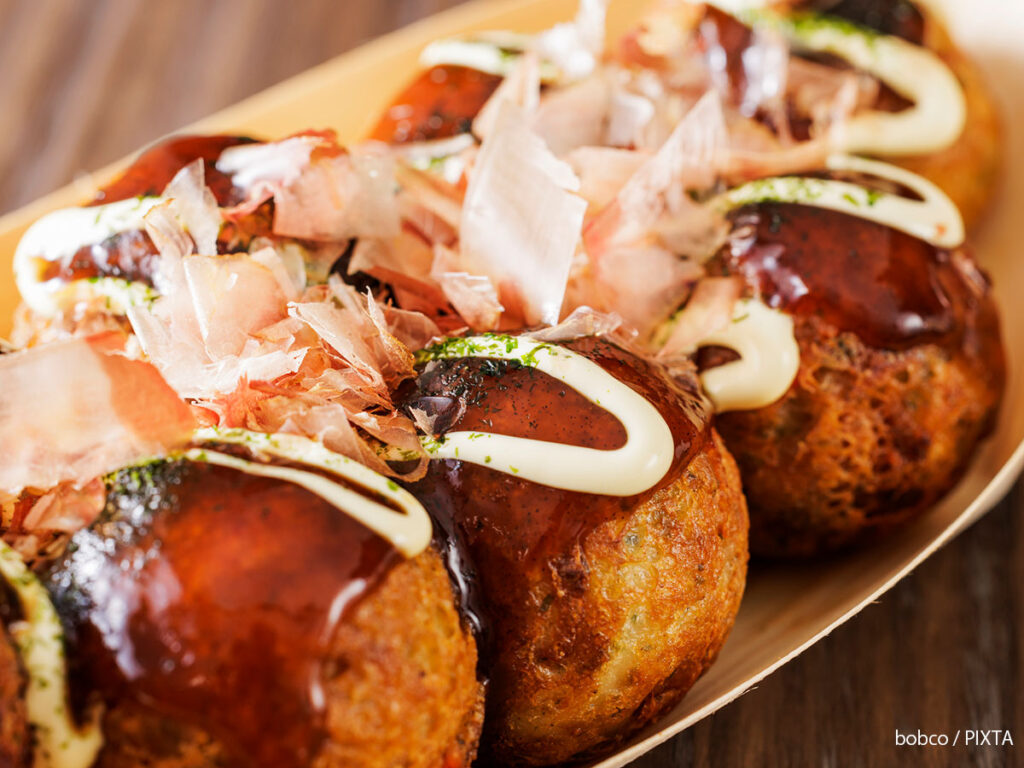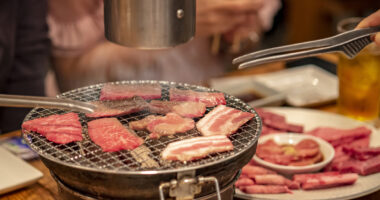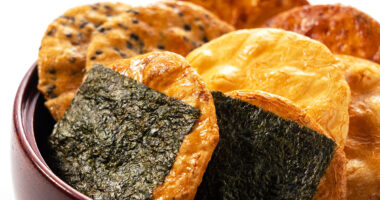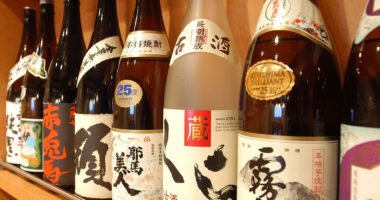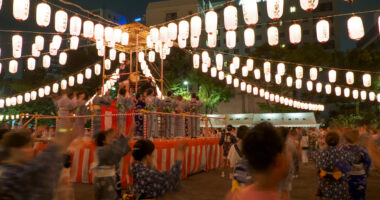Takoyaki (often translated as “octopus dumplings”), a quintessential Japanese dish, captivates food lovers worldwide. Made from a wheat flour batter with small octopus pieces and shaped into balls, it boasts a crisp exterior and a soft, gooey interior. Originating in Osaka, takoyaki is now cherished across Japan, with regional variations adding distinct flavors.
To explore the broader allure, history, and must-try dishes of Japanese cuisine, including regional specialties like takoyaki, see our article, “Traditional Japanese Foods: Explore Japan’s Culinary Culture and History .”
For visitors, discovering takoyaki’s diverse flavors offers a delightful way to deepen your understanding of Japan’s rich food culture.
What does takoyaki taste like?
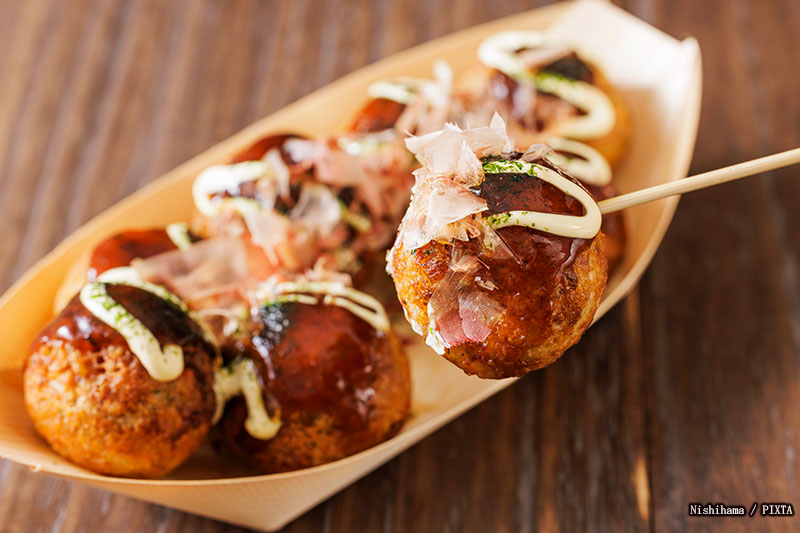
Takoyaki (photo for illustrative purposes)
Understanding takoyaki’s taste starts with its core components. Simple ingredients combine to create a complex, deeply satisfying flavor.
Batter’s flavor and dashi’s role
Takoyaki’s batter, made by mixing wheat flour with dashi broth, delivers a gentle, Japanese-style flavor even on its own. The dashi (broth), typically derived from kombu (kelp) or katsuobushi (bonito flakes), varies by region or shop. Kansai-style takoyaki emphasizes mild kombu dashi, while Kanto-style often uses richer katsuobushi dashi.
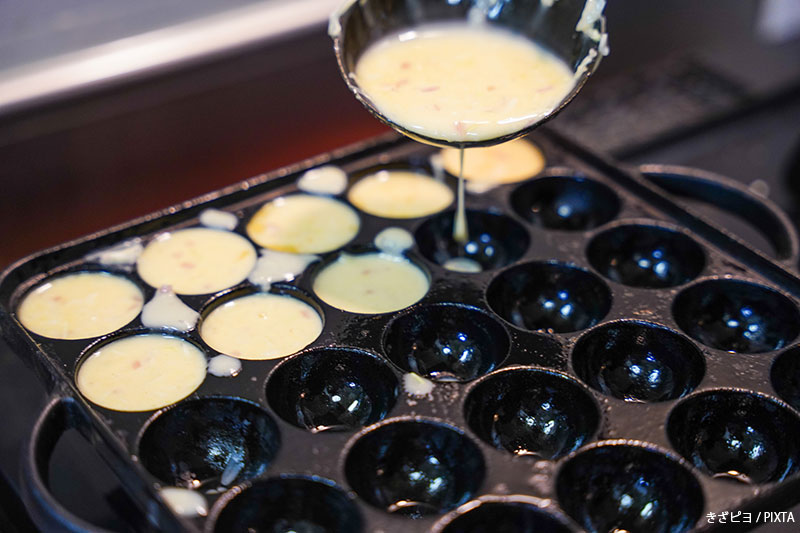
Takoyaki batter (photo for illustrative purposes)
Eggs in the batter create a fluffy, creamy texture and a mellow taste, enhancing its signature softness.
Octopus’s texture and umami
The star ingredient, octopus, gives takoyaki its name. Though some may be unfamiliar with octopus, its chewy texture and subtle flavor anchor the dish. The size and cut of the octopus affect the experience: larger pieces offer a hearty bite, while smaller ones blend seamlessly with the batter.
Tempura scraps and pickled ginger’s role
Tenkasu (small tempura bits) mixed into the batter add a toasty depth and textural contrast, enhancing the eating experience.
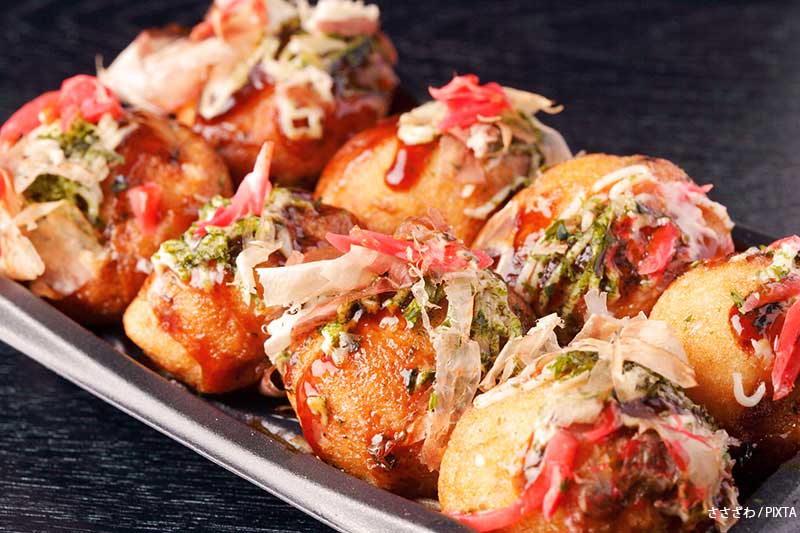
Takoyaki topped with pickled red ginger (photo for illustrative purposes)
Finely chopped beni shōga (pickled red ginger) in the batter brings a refreshing tang and slight spiciness, balancing the dish. This prevents the rich takoyaki from feeling heavy, ensuring it remains easy to eat.
Flavor variations from classic toppings
Toppings are pivotal to takoyaki’s taste. Different toppings transform the same batter and octopus into diverse flavor profiles.
Takoyaki sauce’s sweet-savory balance
The most common topping, takoyaki sauce, offers a sweet-savory flavor. Made from vegetables and fruits, it blends sweetness with mild acidity and subtle spices. Sweeter than Worcestershire sauce but milder than yakisoba sauce, it complements takoyaki’s flavor perfectly.
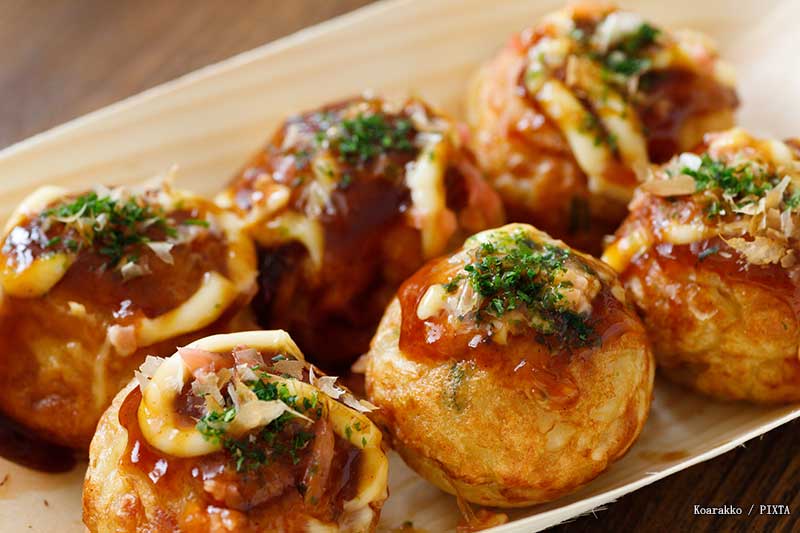
Takoyaki with classic toppings (photo for illustrative purposes)
The sauce’s richness enhances the batter’s simplicity, creating a robust taste. Adjusting the amount allows for a light or bold flavor, tailored to preference.
Mayonnaise’s creamy touch
Mayonnaise adds a creamy, mild dimension to takoyaki. Its tanginess and fat content soften the sauce’s sweet-savory intensity, making the dish more approachable.
The combination of mayonnaise and takoyaki sauce creates a uniquely Japanese balance of sweetness, acidity, and umami. This pairing is beloved across all ages in Japan.
Aonori and katsuobushi’s aroma
Aonori (dried seaweed flakes) sprinkled on top infuses takoyaki with a marine aroma and briny flavor, enhancing its complexity.
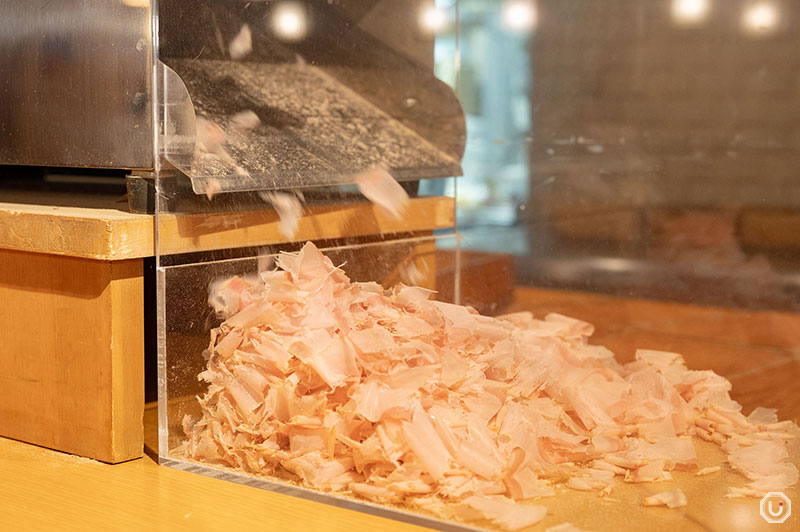
Katsuobushi are a classic takoyaki topping that adds visual appeal
Katsuobushi, another common topping, adds umami and visual delight as it dances on the hot takoyaki, amplifying both flavor and appeal.
Regional flavor differences
While takoyaki is loved nationwide, regional variations in preparation and seasoning offer diverse experiences, enriching its cultural significance.
Osaka’s traditional flavor
Takoyaki reigns as an Osaka specialty. Authentic Osaka takoyaki features a fluffy, gooey batter with robust dashi flavor. Emphasizing kombu dashi, the batter itself carries deep umami, ensuring satisfaction even with minimal toppings.
Osaka’s home-cooking culture means families pass down unique recipes and techniques, creating subtle variations even within the city.
Kanto-style takoyaki
In Kanto, takoyaki diverges from Osaka’s style. The batter is often firmer, offering a more structured texture.
Kanto-style favors bold katsuobushi dashi and generous toppings, delivering a richer taste. These differences create distinct dining experiences within the same dish.
Akashiyaki’s distinct profile
Comparing takoyaki to akashiyaki (egg-rich octopus balls) clarifies its uniqueness. A specialty of Akashi, Hyogo, akashiyaki uses a softer, egg-heavy batter.
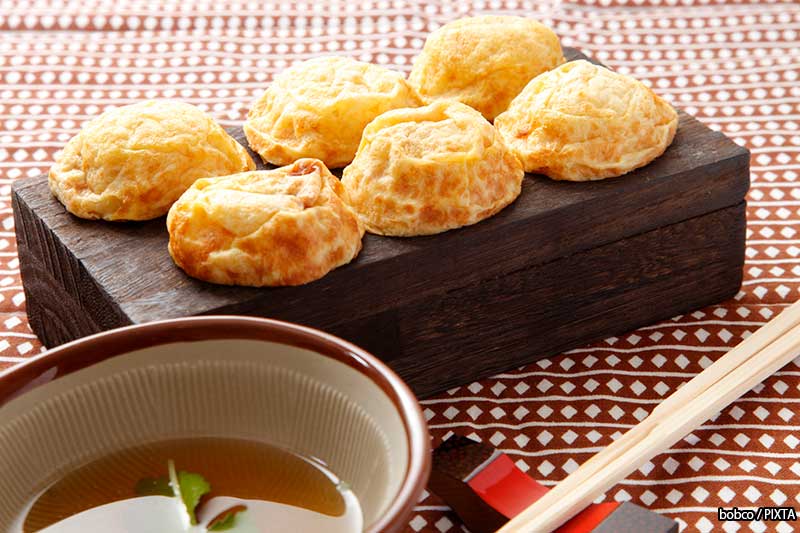
Akashiyaki (photo for illustrative purposes)
Eaten dipped in dashi broth without sauce, akashiyaki highlights the batter and octopus’s natural flavors. This contrast underscores how takoyaki’s sauce and toppings shape its distinctive taste.
Innovative takoyaki flavors
Beyond traditional recipes, creative takoyaki variations have emerged, expanding its appeal with fresh twists.
Salt-seasoned takoyaki’s lightness
Salt-seasoned takoyaki swaps sauce for a simple sprinkle of salt. This highlights the batter’s dashi and octopus’s umami, offering a refined, light flavor.
Often paired with lemon or yuzu, it delivers a clean aftertaste. Popular with health-conscious diners, this lower-calorie style is gaining traction.
Cheese takoyaki’s richness
Cheese takoyaki incorporates cheese into the batter or as a topping, adding a rich, salty depth. The cheese’s umami complements the dashi, creating a Japanese-Western fusion.
This bold flavor, especially popular with younger crowds, pairs cheese’s creaminess with takoyaki’s soft texture for a novel experience.
Mentaiko takoyaki’s spicy kick
Mentaiko takoyaki, featuring Kyushu’s spicy cod roe, adds a fiery, distinctive flavor as a topping or filling. The saltiness and heat of mentaiko (spicy cod roe) create a sophisticated, savory profile.
This seafood pairing exemplifies Japan’s knack for blending marine flavors, making it a perfect sake or beer companion.
Other creative toppings
Modern takoyaki embraces global toppings like curry powder, kimchi, avocado, or bacon. These innovations broaden takoyaki’s appeal, offering diverse taste experiences.
Alternative seasonings and flavors
Beyond traditional sauce, new seasonings like dashi soy sauce and others are redefining takoyaki’s flavor possibilities.
Dashi soy sauce’s elegance
Dashi soy sauce lends takoyaki a refined, Japanese-style flavor. Its soy-based seasoning complements the batter’s dashi, creating a cohesive, deep taste.
The soy’s saltiness and umami enhance the batter’s sweetness, offering a sophisticated, understated flavor popular with mature palates.
Ponzu and citrus seasonings
Ponzu (citrus soy sauce) or lemon juice adds a tangy accent, cutting through takoyaki’s richness for a lighter finish. Citrus acidity highlights the octopus’s sweetness, amplifying the ingredients’ natural flavors. This is especially popular in summer for its refreshing quality.
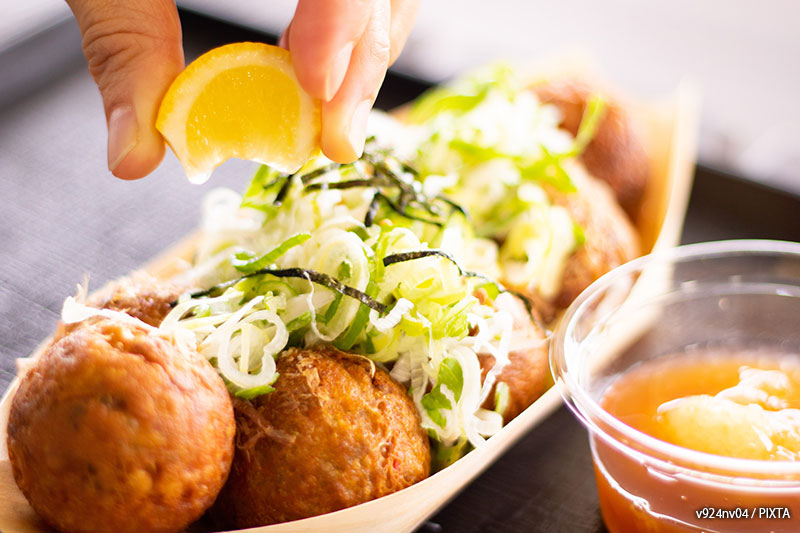
Ponzu takoyaki (photo for illustrative purposes)
Spicy seasonings
Spices like shichimi tōgarashi (seven-spice blend), curry powder, or garlic powder add bold accents. Shichimi tōgarashi, a traditional Japanese spice, tightens takoyaki’s flavor with a spicy kick, blending seamlessly with its profile.
| Seasoning | Flavor Profile | Texture Impact |
|---|---|---|
| Dashi Soy Sauce | Refined, Japanese-style, cohesive with dashi’s deep umami | Enhances moistness |
| Ponzu/Lemon Juice | Tangy acidity highlights octopus’s sweetness | Light, refreshing mouthfeel |
| Shichimi Tōgarashi | Spicy kick tightens overall flavor | Adds a tingling accent |
| Curry Powder/Garlic Powder | Aromatic, spicy, adds new depth to sweet-savory base | Emphasizes crispness, lingering aroma |
Takoyaki’s texture and enjoyment
Takoyaki’s charm lies not only in its flavor but also in its diverse textures. The contrast between a crisp exterior and a gooey interior creates a uniquely enjoyable experience.
Ideal texture balance
Takoyaki’s perfect balance features a crisp, toasty exterior and a gooey, melting interior revealed with each bite. This textural contrast elevates its appeal.
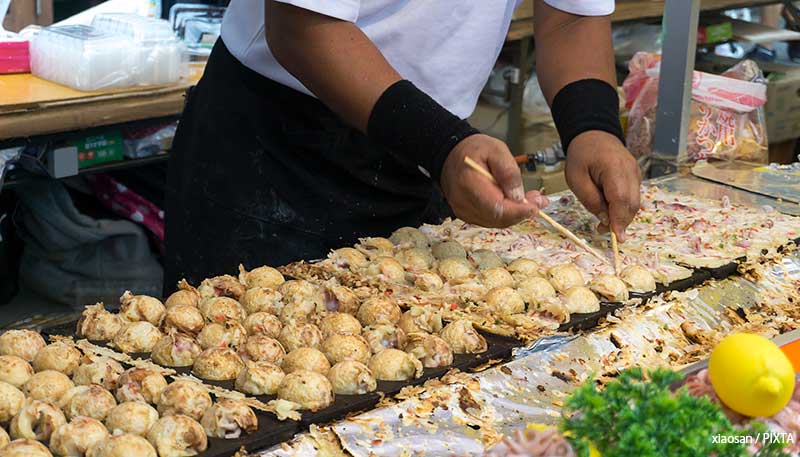
Takoyaki grilled fresh at a summer festival (photo for illustrative purposes)
Cooking time alters texture: a well-cooked exterior offers a strong crunch, while a lightly cooked one provides a softer bite. Choosing your preferred doneness is part of the fun.
Temperature and flavor
Takoyaki is best enjoyed hot. Temperature significantly impacts flavor, with warmth intensifying dashi’s aroma and octopus’s umami.
Hot takoyaki delivers a melting texture and unique flavor that cools takoyaki can’t match. As the interior is scalding fresh off the grill, take care to avoid burns.
Conclusion
Takoyaki’s flavor, born from simple ingredients, is complex and profound. From the batter’s dashi base to the octopus’s umami and diverse toppings, it offers endless variations.
From Osaka’s traditional style to modern innovations, takoyaki continues to evolve. Classic sauce and mayonnaise, or inventive salt, cheese, or mentaiko versions, each bring unique charm, delighting diverse palates.
Visitors to Japan are encouraged to try various takoyaki styles to experience the richness of this iconic dish. Savor its crisp-gooey texture and dive into the depth of Japanese culinary culture.
